This is the first in a series of notes to fifteen lectures for my class Culture and Communication. It is a significant rewrite of the earlier introduction that I used between 1999 and 2004. It is related to the development of my interest in education, "broadly defined," understood as cultural production
- Dewey, John Democracy and education. New York: The Free Press. 1966 [1916]. (Chapters One & Two [on line])
- Varenne, Hervé "America and I" in America as a foreign culture. Ed. by P. DeVita and J. Armstrong, 29-38. Belmont, CA: Wadsworth Publishing. 1992
It is strongly suggested that the two articles "required" for today's class, be read before the mid-term exam. The reading by Dewey is particularly important to understand the historical continuities in the problematics of "culture" and "communication" that this course will challenge. My own article is useful as a general introduction to my attitude towards several of the overall issues we will be addressing. It was written for undergraduates in introductory courses in
How come we are doing
whatever it is that we are doing here and tonight?
A cultural (historical),
communicational (interactional, conversational),
educational (transformational)
puzzle
- Prologue
- In his major work on Education and Democracy, John Dewey states that "social life is identical with communication" (1966 [1916]: 4-5). He
writes the statement as a general truth with major consequences for education.
- But, many of us have moved around the world: is it always a problem? Can we work with each other without sharing much?
- My task in this course is to explore Dewey's statement in terms of the experience of so many who confront the established, work with it, and sometimes transform it. What justifies Dewey's statement? What are the consequences of working with it? What must be criticized? What else can we say and with what consequences?
- In his major work on Education and Democracy, John Dewey states that "social life is identical with communication" (1966 [1916]: 4-5). He
writes the statement as a general truth with major consequences for education.
- Introduction
- By equating
- "social life" with
- "communication", communication with
- "consensus," and making consensus a product of
- "education,"
Dewey opens a wide range of problems (a "problematics") that have fascinated philosophers, social scientists, politicians and educators. After 100 years (or 200 depending on how far one traces the history of this problematics) educators, and all social scientists as a matter of fact, cannot consider the issue moot--on the contrary.- I trace Dewey's particular form of this problematics to the American pragmatists. In American sociology, Talcott Parsons developed a closely related problematics though he claimed to build it more on the European traditions centering on Durkheim and Weber. All this is matter of continuing debate as it become clear that very different readings of both are possible (Hilbert 1992; Garfinkel 2002; Rawls).
- I will work with this problematics.
I will explain its roots and developments. And I will continually challenge it in some of is major correlates. In brief:
- culture, communication, education are different ways of approaching the same phenomenon;
- each emphasize a different aspect:
- "culture" makes us question the lack of determination or motivation by any other aspect of human life of what human life actually consists of:
- physics: human beings can make themselves fly;
- biology: human beings can make themselves born is all sorts of ways;
- sociology: human beings can make many different kinds of adaptations to the difficulties of living together.
- "communication" makes us question the means developed by human beings to bridge the gap between their bodies (humans are not islands onto themselves)
- "education" makes us notice that human beings are always both the objects and subjects of efforts (performed communicatively) deliberately to transform them (and thus become involved in the the further culturing of human life).
- "culture" makes us question the lack of determination or motivation by any other aspect of human life of what human life actually consists of:
- above all, each is not to be treated as a different realm even though research and theoretical development so far has often made it appear as if they were different realms.
- The overal problematics has two aspects
- a technical aspect: what is involved in making human beings human as we know them?
- a moral aspect: given that all political systems are man-made how are we to make institutions (curricula, pedagogy, programs) for others to use and build democracy with (can there be anti-hegemonic hegemonies?)
- Our task in this course is to address the technical (theoretical and methodological) problems.
- But this technical problem would not be so pressing without the second set of problems: as educators we build and shape. This requires a moral evaluation of what must be done as well as an assessment of what is doable and how.
- Still, without a clear understanding of the technical issues, practical morality (what we, as teachers, reformers, etc. practice) is in fact not quite moral (ethical?).
- By equating
- Concretely
Note that I am not defining a concept but indexing the kind of event we are concerned with
This is what all theories of culture, communication, education are about:
`And only one for birthday presents, you know. There's glory for you!'
`I don't know what you mean by "glory",'
Alice said. Humpty Dumpty smiled contemptuously.
`Of course you don't -- till I tell you. I meant "there's a nice knock-down argument for you!"'
`But "glory" doesn't mean "a nice knock-down argument",' Alice objected.
`When I use a word,' Humpty Dumpty said, in rather a scornful tone, `it means just what I choose it to mean -- neither more nor less.'
`The question is,' said Alice, `whether you can make words mean so many different things.'
`The question is,' said Humpty Dumpty, `which is to be master -- that's all.' (Lewis Carroll, Through the Looking Glass, Chapter 6 , 1865)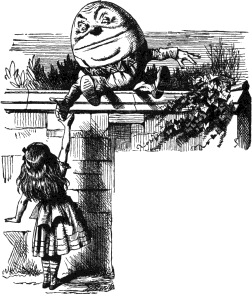
Alice and Humpty Dumpty converse about conversation, language, meaning, sharing. He instructs her, she challenges, he counter-challenges, she yields, and yet she continues to question
- Do words have meaning? not by themselves
- Who decides about meaning? it all depends on who is master (power and authority)
- Can you do it by yourself? No, you need a little help from our friends and all sorts of things might be possible-including [not] growing up (see earlier in the same dialogue with Humpty Dumpty)?
- And, anyway:
- how does one find out about all this (learning)?
- what is the product of having to learn (ignorance)?
- what is one to do? (seek, question, play)
-
Another Example:Embodiment and Popular Culture
These problems can be illustrated by looking carefully at the following set of pictures and questioning what we see and how we see, what we report to each other, and how we do this.
- Imagine a three to four year old girl, standing alone in a school yard, perhaps waiting for an adult to come and pick her up. A man she does not know approaches and take a series of pictures. As she notices his activity her physical stance changes.
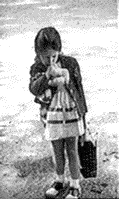
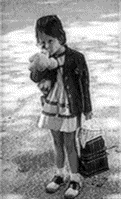
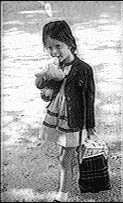
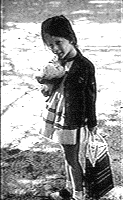
See also the animated version of these images to get a better sense of the transformations in the little girl's stance, as well as further discussion of how these images may help us clarify fundamental questions in communication theory. Now compare her final stance to the stance of two models as published in an advertisement of the same period.
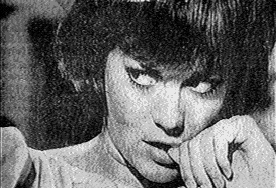

Pictures taken from Paul Byers' "Cameras Don't Take Pictures." (1966) The similarities in these poses are striking. (Note the bends in the body, the way the head leans and the eyes look up, the thumb on the lip). (for more, see Goffman's Gender Advertisement, N.Y., Harper and Row,1974)
What are we to make of the changes in bodily and this similarity ? What are we to make of the possible changes in what advertisers consider alluring over the past 50 years?
- Should we talk of enculturaltion and learning (thereby suggesting that a four year old is already fully aware of bodily patterns of stereotypical seduction poses?)
- Should we talk about sharing, consensus and, at least by implication, acceptance by the little girl of cultural patterns that, at the same time when this picture was taken a group of famous feminists were attacking.
- Are we entitled to say that the cultural patterns embodied by the little girl, and the grown women in the advertising pictures, are "their" culture?
- What about the photographer who hides himself behind the pictures but is in fact directly engaged by the little girl as she notices his activity. Is he responsible for getting the little girl into the pose? Is the cultural production that he triggers "his" culture too?
- What about the professor who proposes all this as a theoretical exercise?
- Might we say that the little girl is learning as she shifts her body as she begins the interaction with the photographer and slowly get into a position which the photographer invites her to take, in spite of himself perhaps, but which he then has to accept as the end of the sequence.
- Might we perhaps say that the cultural patterns are in fact external constraints embodied and performed by girl, photographer, advertising agency, and eventually all of us, as we expect a reaction to our move and must then acknowledge our interlocutors performance as somehow responsive.
These are the kind of question which are still being asked even as 50 years of research has greatly expanded our understanding and refined our debates